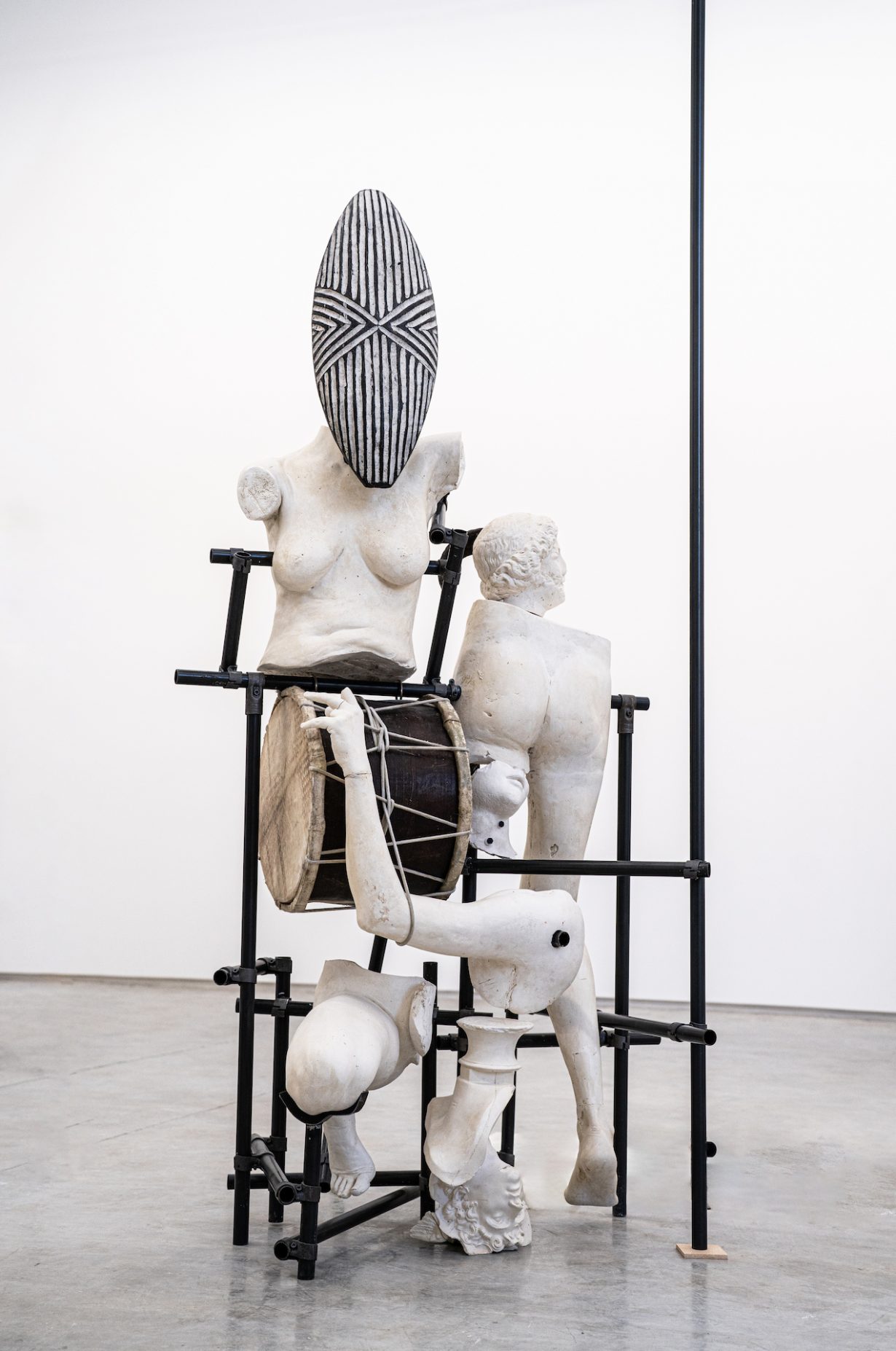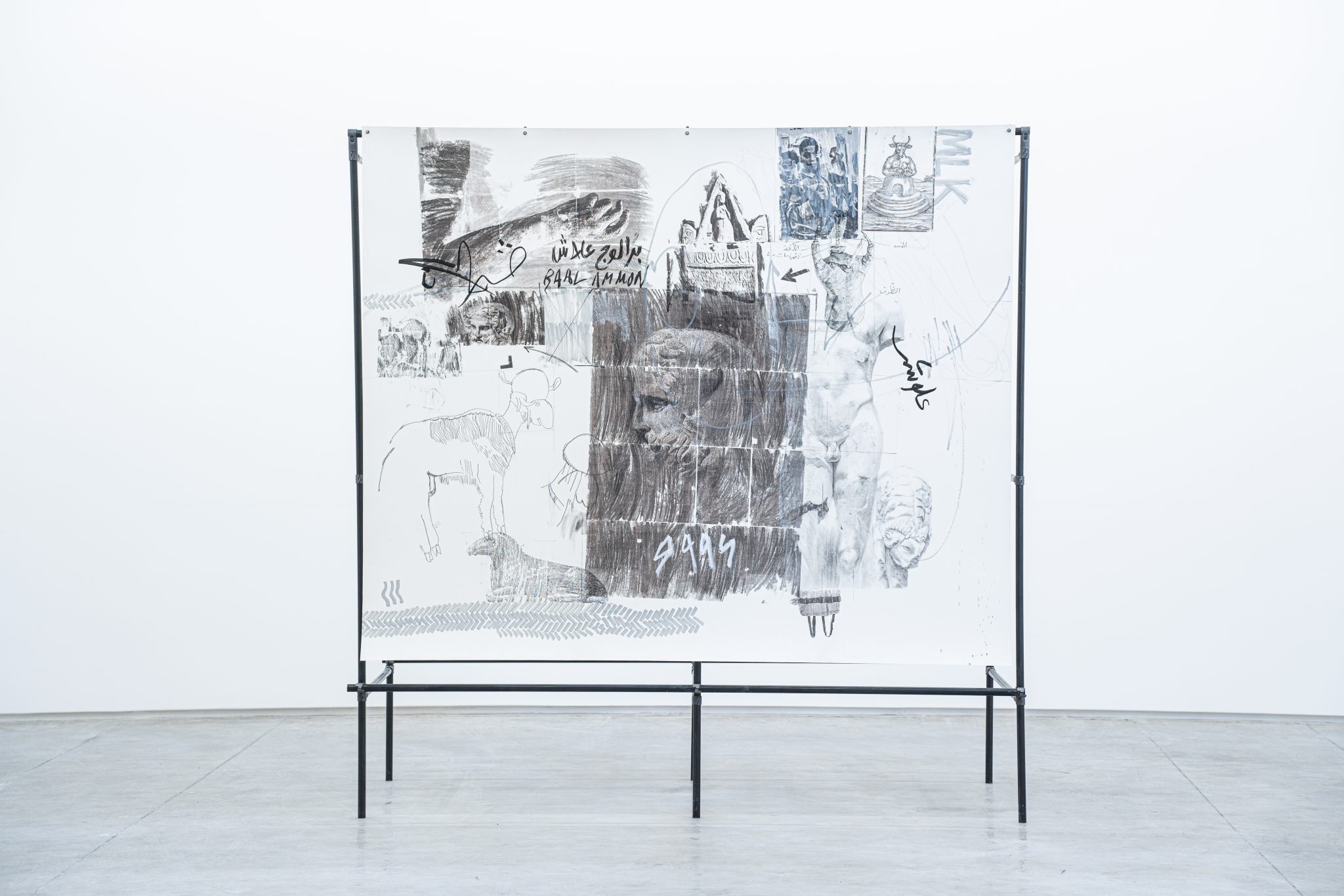For all its often violent iconoclasm, Et si Carthage? at Selma Feriani, Tunis bears a spectral presence
In the middle of Selma Feriani’s new space in Tunis (she has been operating in the Sidi Bou Said district since 2013), 250 × 200 cm sheets of paper hang from black scaffolding and are covered with monochrome ink-and-graphite drawings, transfers and annotations. This is the Tunisian artist Nidhal Chamekh’s Et si Carthage? – which takes its cue from the philosopher Édouard Glissant, who posited in his thinking and writing, ‘What if Carthage had not been destroyed?’ – operating in a speculative space between the rubble of the past and an alternative view of the present. Indeed, the ruins of the ancient civilisation of Carthage (razed by Roman conquest in 146 BCE) still punctuate the city’s contemporary landscape.
Chamekh’s iconography in these works on paper is various: blueprint designs of monolithic Roman structures and weaponry sit beside defaced photographs of early-twentieth-century European generals, pixelated documentary stills and museum-catalogue images of North African artefacts; Chamekh’s own spare commentaries accompany them like annotations, and offer a linguistic record of Tunis’s imperial history: Arabic, French, Italian and Latin. Gestural graphite strokes slash across the paper like vehicle skidmarks. Decapitated, dismantled or loose fragments of mock-Roman statues – all sculpted by Chamekh – collect beneath the scaffold structures, while others sit atop museum shipping containers. Between the images derived from Ancient Rome are those from North and West Africa; presented in tandem and conflict with one another, they act as analogies for the respective positions of conqueror and conquered.

There is something cathartic at play in the violent iconoclasm Chamekh mounts: here, an Ivorian mask seems to squash a Hellenic bust, there, black scaffold poles impale the torsos of his white-plaster sculptures. Beside a diagram of a disassembled rifle in the work on paper Et si Carthage? #4 (2023), a contemporary photograph of a white man posing before a dead elephant is labelled ‘hunter’, his face circled and a triangle marked above his head as if by facial recognition software or for a videogame character – Chamekh utilising the visual language of military invasion and border control on white transgressors. Elsewhere, deviations from the main space are less contributions and more constellations: in a side room, smaller works collage sketches and photographs to form composite figures on rectangular wire grids, compressed versions of the main space’s ambition; Chamekh’s research materials, archival photographs and documents are presented on the gallery’s mezzanine, each item connected by orderly, rhizomatic black lines; the display of video research – including clips from the 1959 Italian film Hannibal and an interview with Glissant – screening in the basement feels like an exercise in filling space.
For a show based on a conditional proposition, it’s unclear what Chamekh is really trying to do with Glissant’s speculative idea. In the absence of any compelling vision of the future, Et si Carthage? is at its best when the present day interrupts Chamekh’s array of ancient imagery. In another work on paper (Et si Carthage? #2, 2023), a transfer print of a lifeboat vest emerges from behind a graphite sketch of a Graeco-Roman-style statue. Across the room, an Ikea-like diagram of a small wooden boat is printed matter-of-factly onto another scaffolded work on paper. After all, just 80km east of Tunis lies Diyar al Hajjaj, a small town and regular throughpass for Tunisians making the treacherous journey across the water to the Italian island of Pantelleria, and thus to Europe. Most are sent back by the Italian government; a few slip through the legal cracks; hundreds never reach any shore again. Chamekh’s metaversal concept may look to reappraise or reimagine, but instead highlights something else: thousands of people with real dreams of another life.
Et si Carthage? at Selma Feriani, Tunis, through 24 March
